Description
BOOK DESCRIPTIONThe region of Chihuahua in North-Western Mexico is a relatively isolated area with a barren desert landscape. There is little in the way of the Settlement Archaeology typically found in the Southern regions of Mexico, for instance cities, roads, temples and other large stone structures. However, there is archaeological evidence present in this region that points to a significant culture, important due to the fact that it has a material and cultural merging of both Mesoamerican and Puebloan influences. Because of these combined influences there are different theories as to the origins of this culture, with either the Toltecs or the Anasazi being put forward. The study starts by discussing Chihuahuan Prehistory and ceramic research in this area, as well asthe environment, geography, the archaeological record, and ceramic chronologies. Also discussed are the cultural boundaries, definitions and characteristics of the Medio period (1200-1450)A.D.). The role of decoration in ceramic reconstruction is also covered. The cultural implications of the decorative patterns on the Chihuahuan polychrome jars have up until now been largely ignored. These polychromes are part of a distinct pottery series, and Hendrickson uses the large number of vessels stored in many North American museums to carry out a whole range of contrastive analyses on these jars, both individually, as well as looking at general design patterns for cultural interpretation. The analysis of the design of the polychrome jars is carried out by contrasting levels of design, styles, and other tests, in order to fit individual samples into the typology. Importantly Hendrckson places these assemblages within geographical, cultural and temporal contexts.











